CHEVROLET ASTRO PASSENGER 1994 1.G Owners Manual
Manufacturer: CHEVROLET, Model Year: 1994, Model line: ASTRO PASSENGER, Model: CHEVROLET ASTRO PASSENGER 1994 1.GPages: 340, PDF Size: 16.86 MB
Page 261 of 340
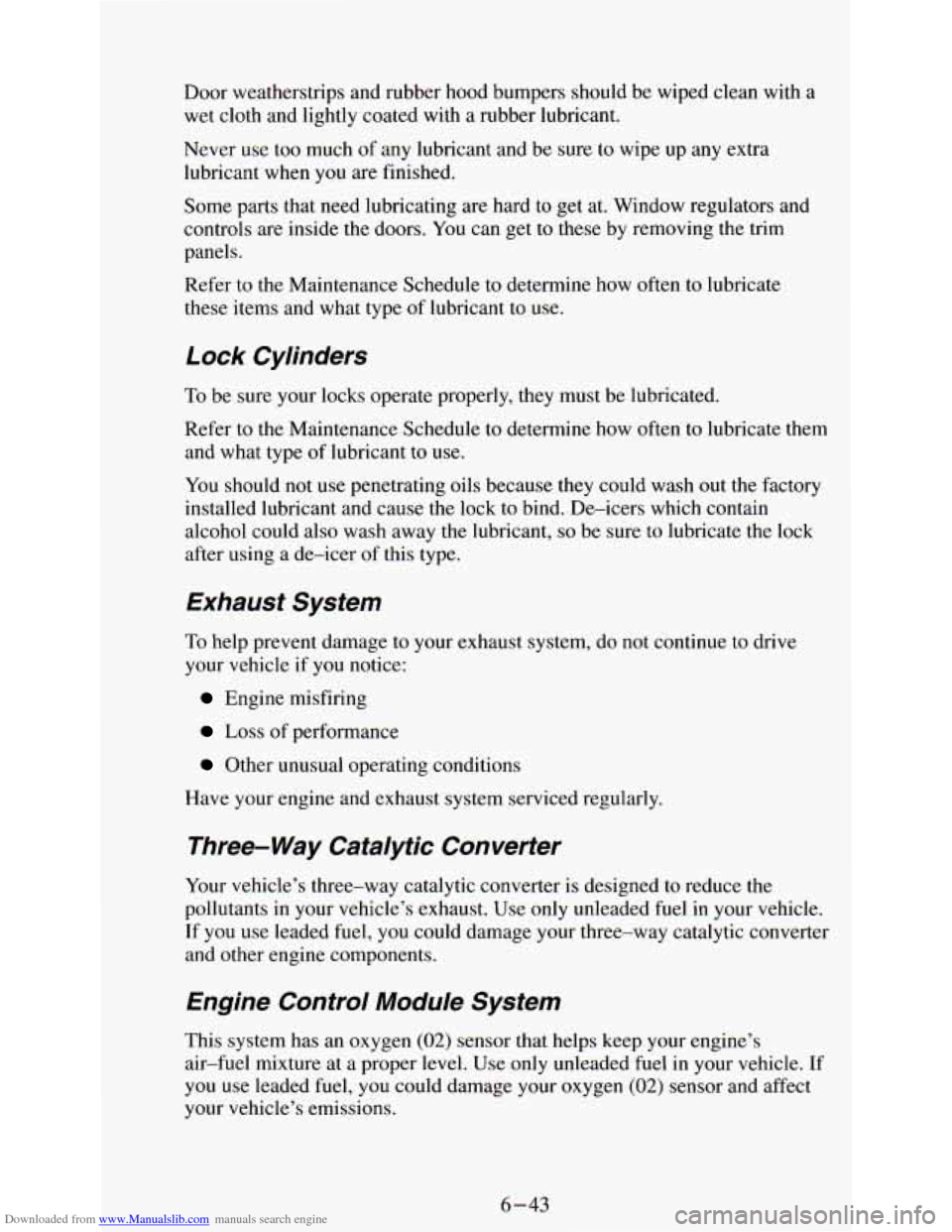
Downloaded from www.Manualslib.com manuals search engine Door weatherstrips and rubber hood bumpers should be wiped clean with a
wet cloth and lightly coated with a rubber lubricant.
Never use too much of any lubricant and be sure
to wipe up any extra
lubricant when you are finished.
Some parts
that need lubricating are hard to get at. Window regulators and
controls are inside the doors. You can get to these by removing
the trim
panels.
Refer to the Maintenance Schedule to determine how often to lubricate
these items and what type
of lubricant to use.
Lock Cylinders
To be sure your locks operate properly, they must be lubricated.
Refer to the Maintenance Schedule to determine how often to lubricate them
and what type of lubricant to use.
You should not use penetrating oils because they could wash out
the factory
installed lubricant and cause the lock to bind. De-icers which contain
alcohol could also
wash away the lubricant, so be sure to lubricate the lock
after using a de-icer of this type.
Exhaust System
To help prevent damage to your exhaust system, do not continue to drive
your vehicle if you notice:
Engine misfiring
Loss of performance
Other unusual operating conditions
Have your engine and exhaust system serviced regularly.
Three- Way Catalytic Converter
Your vehicle’s three-way catalytic converter is designed to reduce the
pollutants in your vehicle’s exhaust. Use only unleaded fuel in your vehicle.
If you use leaded fuel, you could damage your three-way catalytic converter
and other engine components.
Engine Control Module System
This system has an oxygen (02) sensor that helps keep your engine’s
air-fuel mixture at a proper level. Use only unleaded fuel in your vehicle.
If
you use leaded fuel, you could damage your oxygen (02) sensor and affect
your vehicle’s emissions.
6-43
Page 262 of 340
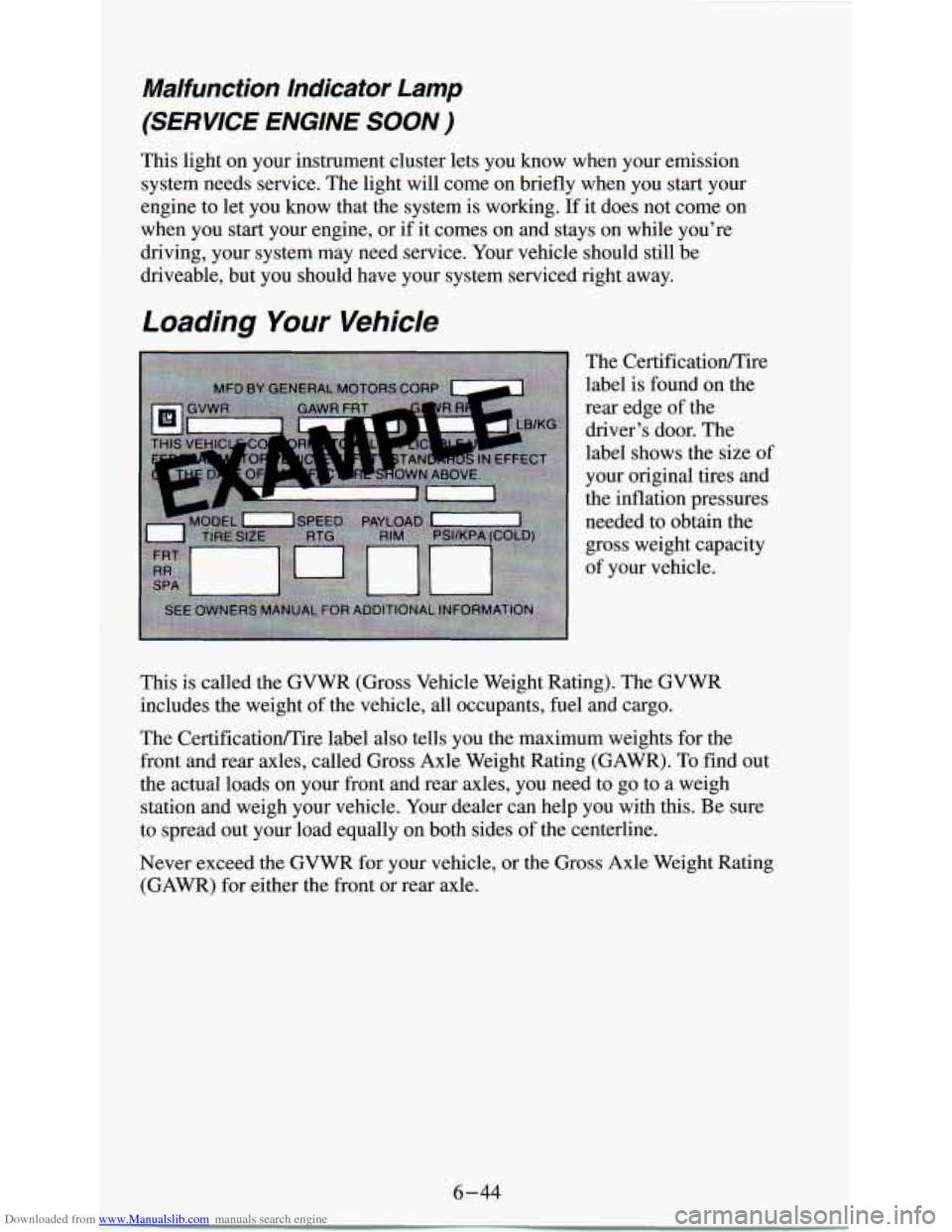
Downloaded from www.Manualslib.com manuals search engine Malfunction Indicator Lamp
(SERVICE ENGINE SOON )
This light on your instrument cluster lets you know when your emission
system needs service. The light will come on briefly when you start your
engine to let you know that the system is working. If it does not come on
when you start your engine, or if it comes
on and stays on while you’re
driving, your system may need service. Your vehicle should still be
driveable, but you should have your system serviced right away.
Loading Your Vehicle
The Certificationire
label is found on the
rear edge of the
driver’s door. The
label shows the size of
your original tires and
the inflation pressures
needed to obtain the
gross weight capacity
of your vehicle.
This is called the GVWR (Gross Vehicle Weight Rating). The GVWR
includes the weight of the vehicle, all occupants, fuel and cargo.
The CertificatiodTire label
also tells you the maximum weights for the
front and rear axles, called Gross Axle Weight Rating (GAWR). To find out
the actual loads on your front and rear axles, you need
to go to a weigh
station and weigh your vehicle. Your dealer can help you with this. Be sure
to spread out your load equally on both sides of the centerline.
Never exceed
the GVWR for your vehicle, or the Gross Axle Weight Rating
(GAWR) for either the front or rear axle.
6-44
Page 263 of 340
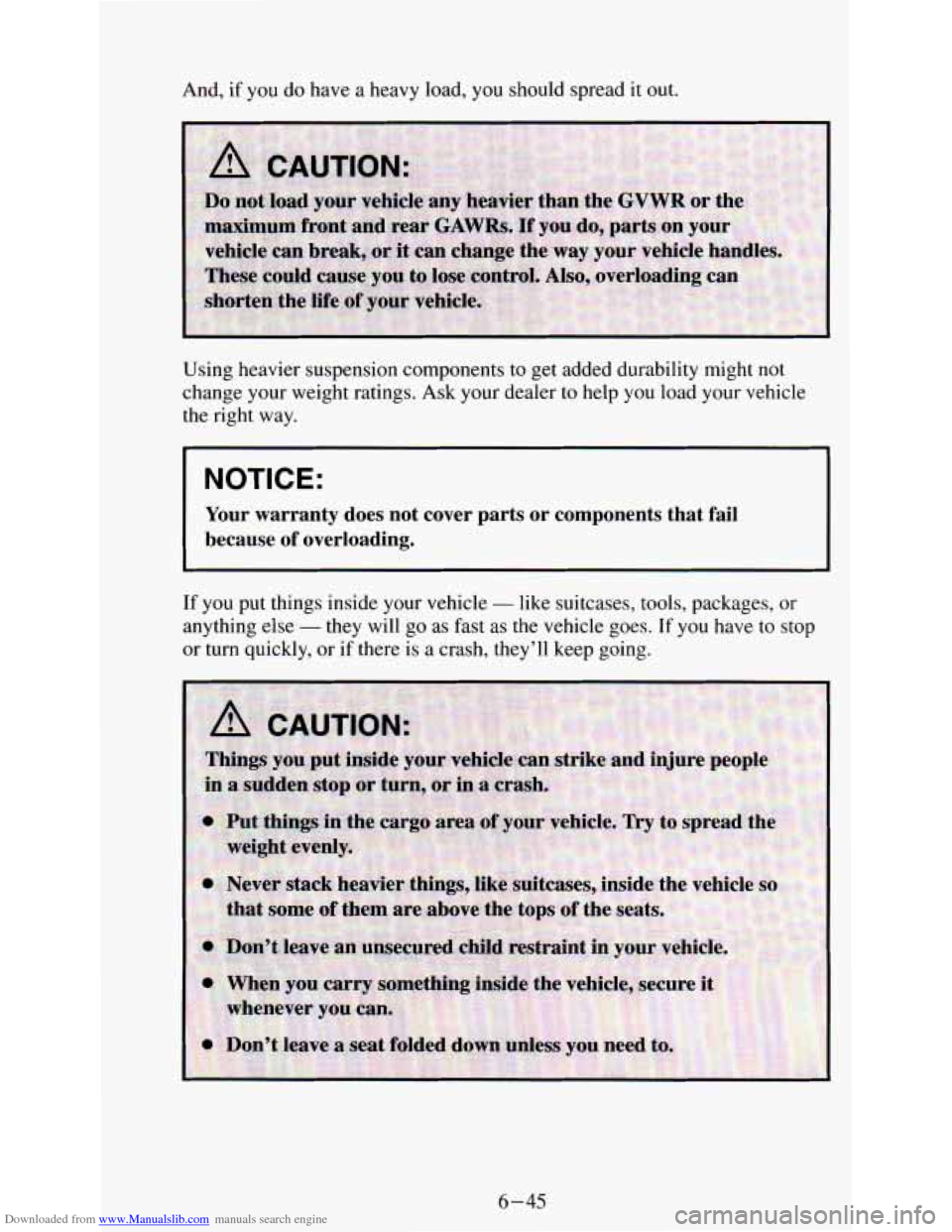
Downloaded from www.Manualslib.com manuals search engine And, if you do have a heavy load, you should spread it out.
Using heavier suspension components to get added durability might not
change your weight ratings. Ask your dealer
to help you load your vehicle
the right way.
I NOTICE:
Your warranty does not cover parts or components that fail
because of overloading.
If you put things inside your vehicle - like suitcases, tools, packages, or
anything else
- they will go as fast as the vehicle goes. If you have to stop
or turn quickly, or if there is a crash, they’ll keep going.
6-45
Page 264 of 340

Downloaded from www.Manualslib.com manuals search engine Payload
The Payload Capacity is shown on the CertificationRire label. This is the
maximum load capacity that your vehicle can carry. Be sure to include the
weight of the people inside as part
of your load. If you added any
accessories or equipment after your vehicle left the factory, remember to
subtract the weight of these things from the payload. Your dealer can help
you with this.
Trailering Package
If your vehicle comes with the Trailering Package, there is also a load rating
which includes the weight of the vehicle
and the trailer it tows. This rating
is called the Gross Combination Weight Rating (GCWR).
When you weigh your trailer, be sure to include the weight of everything
you put in it. And, remember to figure the weight of the people inside as
part of your load.
Your dealer can help
you determine your GCWR.
6-46
Page 265 of 340
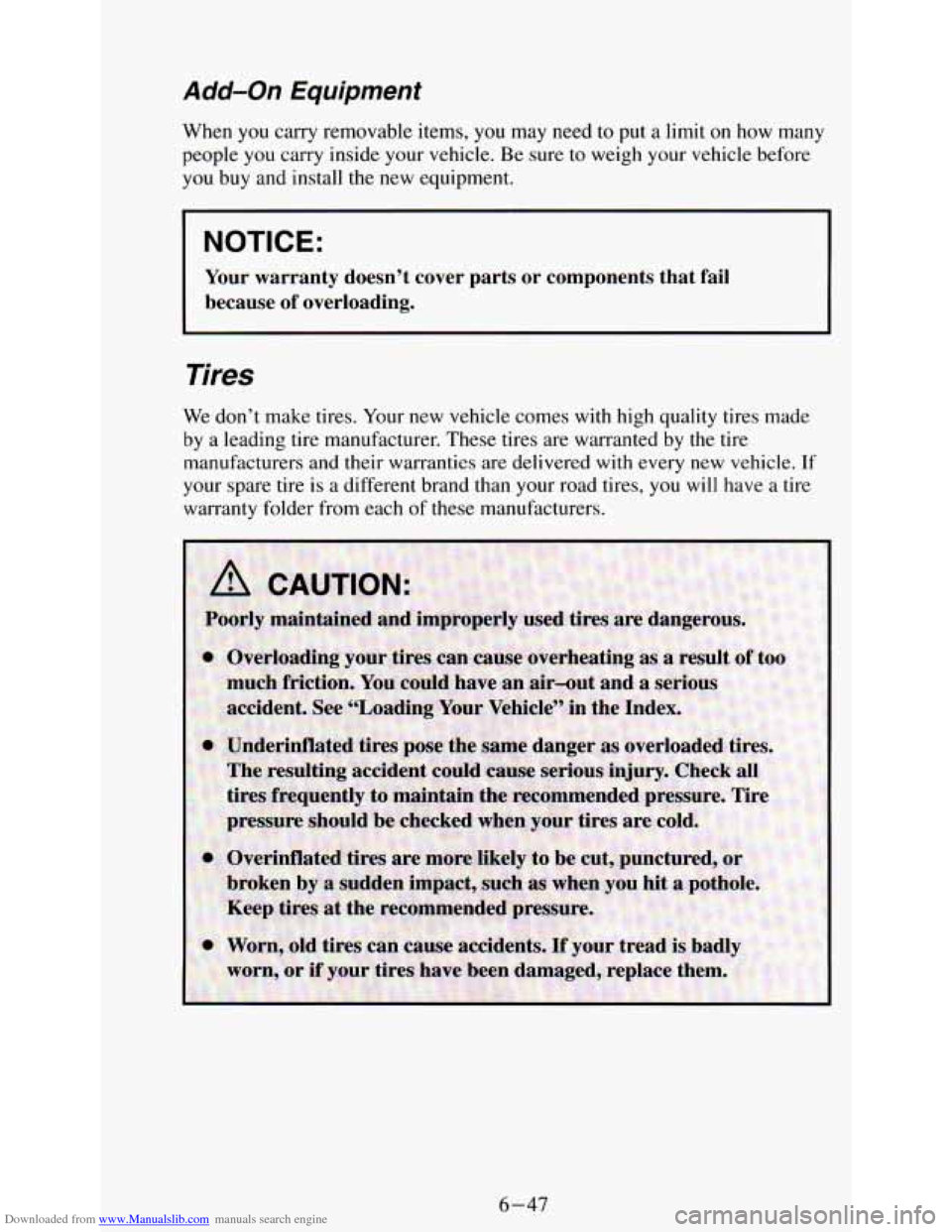
Downloaded from www.Manualslib.com manuals search engine Add-on Equipment
When you carry removable items, you may need to put a limit on how many
people you carry inside your vehicle. Be sure to weigh your vehicle before
you buy and install the new equipment.
NOTICE:
Your warranty doesn’t cover parts or components that fail
because of overloading.
Tires
We don’t make tires. Your new vehicle comes with high quality tires made
by
a leading tire manufacturer. These tires are warranted by the tire
manufacturers and their warranties are delivered with every new vehicle. If
your spare tire is a different brand than your road tires, you
will have a tire
warranty folder from each of these manufacturers.
6-47
Page 266 of 340
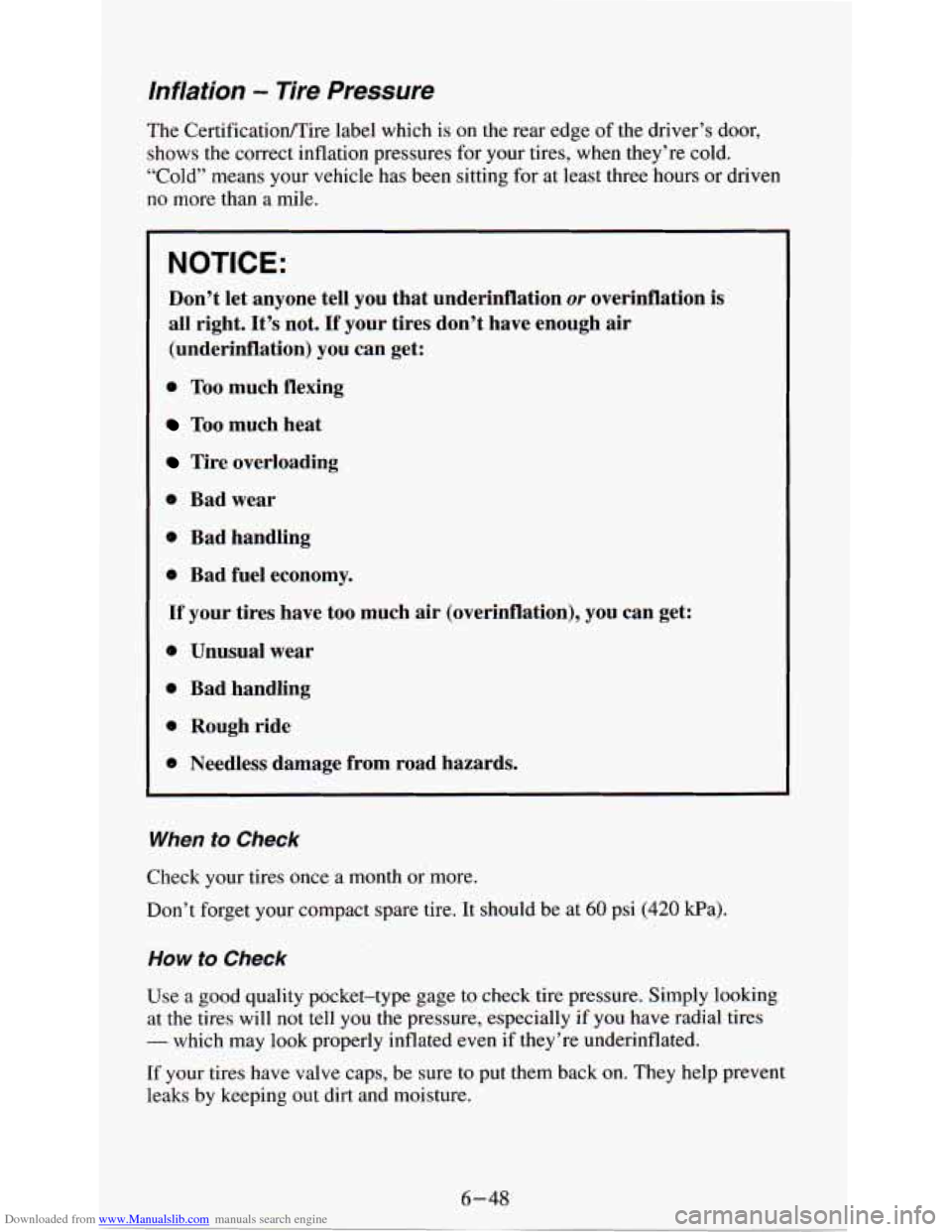
Downloaded from www.Manualslib.com manuals search engine Inflation - Tire Pressure
The Certificatioflire label which is on the rear edge of the driver’s door,
shows the correct inflation pressures for your tires, when they’re cold.
“Cold” means your vehicle has been sitting for at least three hours or driven
no more than a mile.
NOTICE:
Don’t let anyone tell you that underinflation or overinflation is
all right.
It’s not. If your tires don’t have enough air
(underinflation) you can get:
0 Too much flexing
Too much heat
Tire overloading
0 Bad wear
0 Bad handling
0 Bad fuel economy.
If your tires have too much air (overinflation), you can get:
@ Unusual wear
0 Bad handling
6 Rough ride
6 Needless damage from road hazards.
When to Check
Check your tires once a month or more.
Don’t forget your compact spare tire. It should be at
60 psi (420 kPa).
How to Check
Use a good quality pocket-type gage to check tire pressure. Simply looking
at the tires will not tell you the pressure, especially if you have radial tires
- which may look properly inflated even if they’re underinflate\
d.
If your tires have valve caps, be sure to put them back
on. They help prevent
leaks by keeping out dirt and moisture.
Page 267 of 340
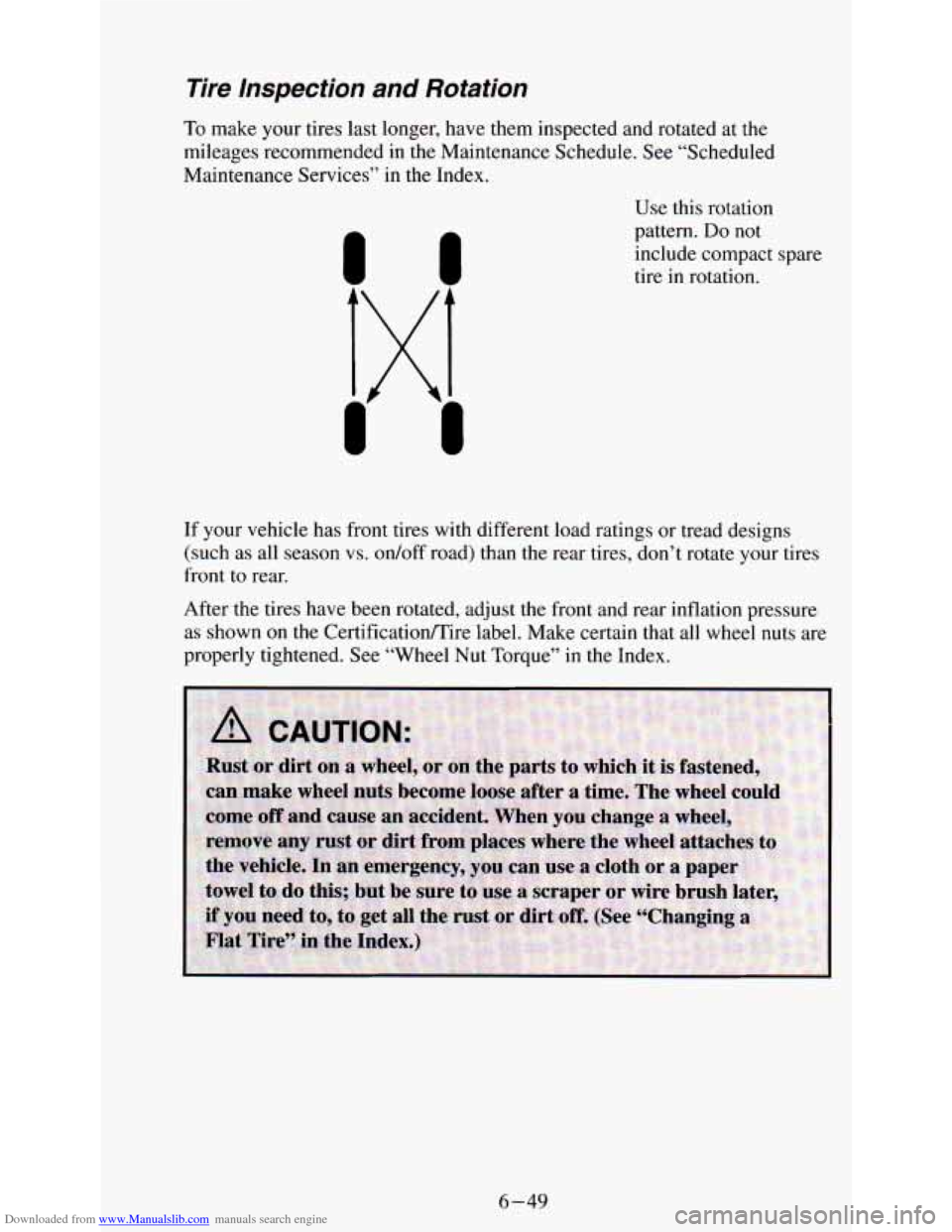
Downloaded from www.Manualslib.com manuals search engine Tire Inspection and Rotation
To make your tires last longer, have them inspected and rotated at the
mileages recommended
in the Maintenance Schedule. See “Scheduled
Maintenance Services” in the Index.
Use this rotation
pattern.
Do not
include compact spare
tire
in rotation.
If your vehicle has front tires
with different load ratings or tread designs
(such as all season
vs. on/off road) than the rear tires, don’t rotate your tires
front to rear.
After the tires have been rotated, adjust the front and rear inflation pressure
as shown on the CertificationEire label. Make certain that all wheel nuts are
properly tightened. See “Wheel
Nut Torque” in the Index.
6-49
Page 268 of 340
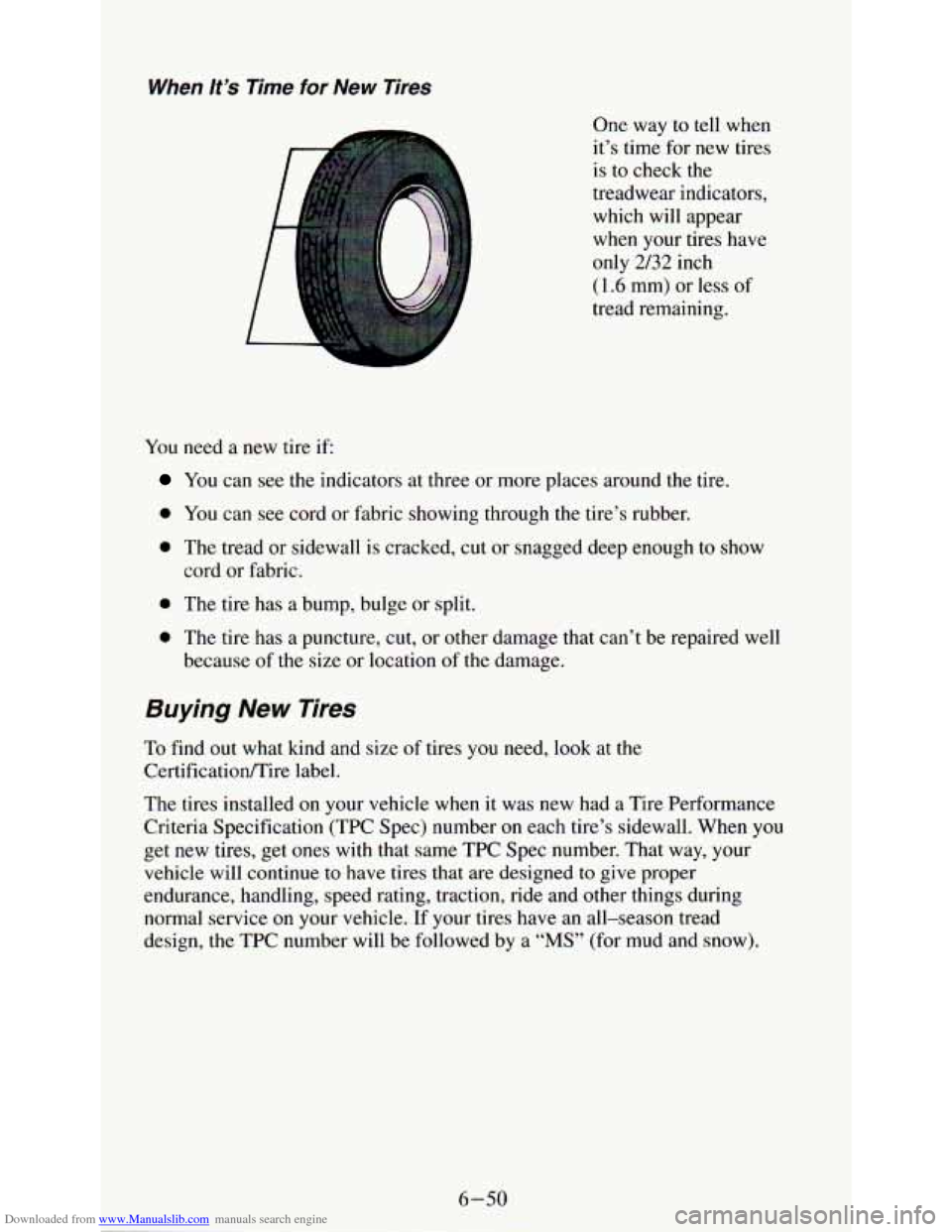
Downloaded from www.Manualslib.com manuals search engine When It’s Time for New Tires
a
One way to tell when
it’s time for new tires
is to check the
treadwear indicators,
which
will appear
when your tires have
only
2/32 inch
(1.6 mm) or less of
tread remaining.
You need a new tire
if
You can see the indicators at three or more places around the tire.
0 You can see cord or fabric showing through the tire’s rubber.
0 The tread or sidewall is cracked, cut or snagged deep enough to show
cord or fabric.
0 The tire has a bump, bulge or split.
0 The tire has a puncture, cut, or other damage that can’t be repaired well
because of the size or location of the damage.
Buying New Tires
To find out what kind and size of tires you need, look at the
CertificationEire label.
The tires installed on your vehicle
when it was new had a Tire Performance
Criteria Specification (TPC Spec) number on each tire’s sidewall. When you
get new tires, get ones
with that same TPC Spec number. That way, your
vehicle will continue to have tires that are designed
to give proper
endurance, handling, speed rating, traction, ride and other things during
normal service on your vehicle.
If your tires have an all-season tread
design,
the TPC number will be followed by a “MS” (for mud and snow).
6-50
Page 269 of 340
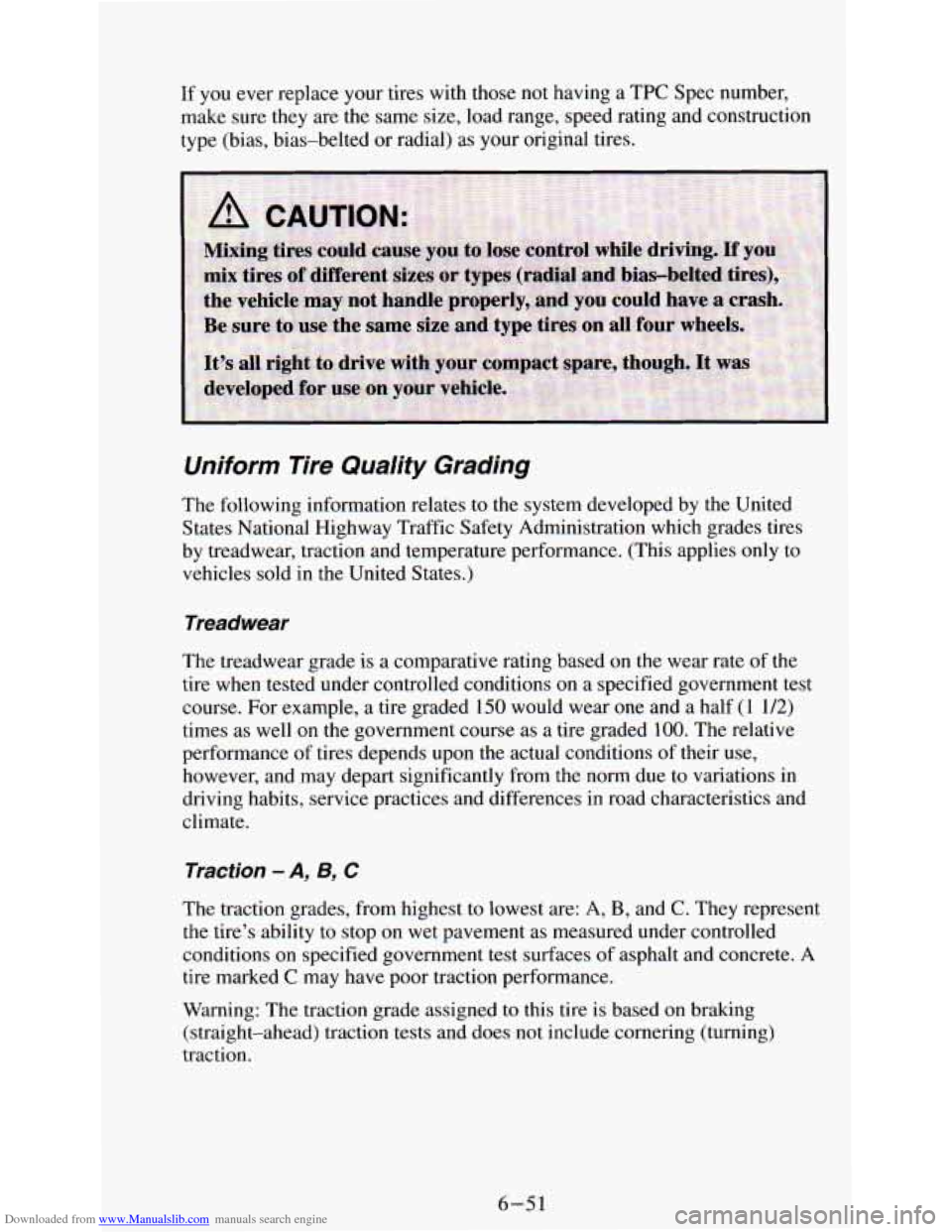
Downloaded from www.Manualslib.com manuals search engine If you ever replace your tires with those not having a TPC Spec number,
make sure they are the same size, load range, speed rating and construction
type (bias, bias-belted
or radial) as your original tires.
_1 - .. .
Uniform Tire Quality Grading
The following information relates to the system developed by the United
States National Highway Traffic Safety Administration which grades tires
by treadwear, traction and temperature performance. (This applies only to
vehicles sold
in the United States.)
Treadwear
The treadwear grade is a comparative rating based on the wear rate of the
tire
when tested under controlled conditions on a specified government test
course. For example,
a tire graded 150 would wear one and a half (1 1/2)
times as well on the government course as a tire graded 100. The relative
performance
of tires depends upon the actual conditions of their use,
however, and may depart significantly from the norm due to variations in
driving habits, service practices and differences in road characteristics and
climate.
Traction - A, 8, C
The traction grades, from highest to lowest are: A, B, and C. They represent
the tire’s ability to stop on wet pavement as measured under controlled
conditions on specified government test surfaces
of asphalt and concrete. A
tire marked C may have poor traction performance.
Warning: The traction grade assigned to this tire is based on braking
(straight-ahead) traction tests and does not include cornering (turning)
traction.
6-51
Page 270 of 340
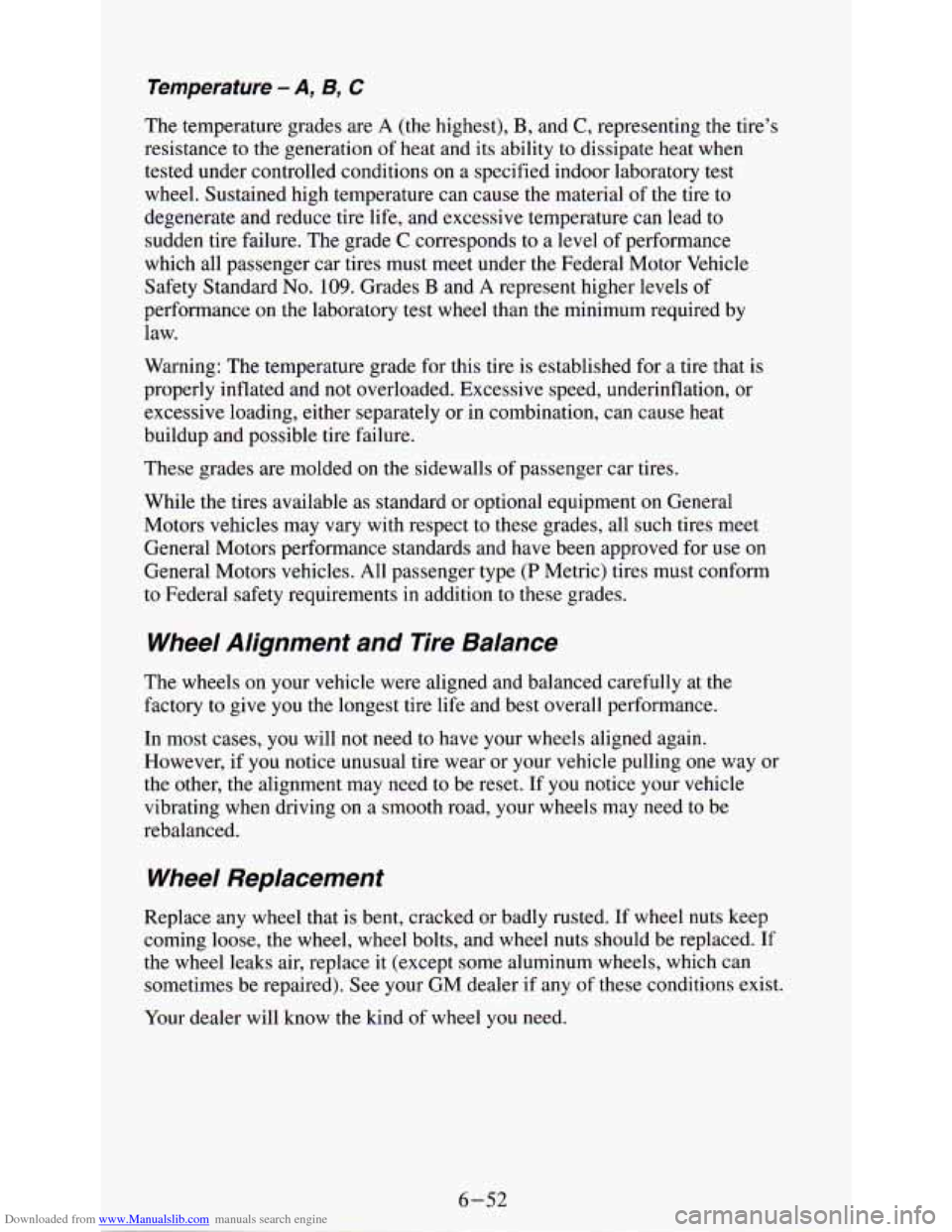
Downloaded from www.Manualslib.com manuals search engine Temperature - A, By C
The temperature grades are A (the highest), B, and C, representing the tire’s
resistance to the generation of heat and its ability to dissipate heat when
tested under controlled conditions on a specified indoor laborat\
ory test
wheel. Sustained high temperature can cause the material of the tire to
degenerate and reduce tire life, and excessive temperature can lead to
sudden tire failure. The grade
C corresponds to a level of performance
which all passenger car tires must meet under the Federal Motor Vehicle
Safety Standard
No. 109. Grades B and A represent higher levels of
performance
on the laboratory test wheel than the minimum required by
law.
Warning: The temperature grade
for this tire is established for a tire that is
properly inflated and
not overloaded. Excessive speed, underinflation, or
excessive loading, either separately or in combination, can cause heat
buildup and possible tire failure.
These grades are molded on the sidewalls
of passenger car tires.
While the tires available as standard or optional equipment on General
Motors vehicles may vary with respect to these grades, all suc\
h tires meet General Motors performance standards and have been approved for use
on
General Motors vehicles. All passenger type (P Metric) tires must conform
to Federal safety requirements
in addition to these grades.
Wheel Alignment and Tire Balance
The wheels on your vehicle were aligned and balanced carefully at \
the
factory to give you the longest tire life and best overall performance.
In most cases, you will not need to have your wheels aligned again.
However, if you notice unusual tire wear or your vehicle pulling
one way or
the other, the alignment may need
to be reset. If you notice your vehicle
vibrating when driving on a smooth road, your wheels may need \
to be
rebalanced.
Wheel Replacement
Replace any wheel that is bent, cracked or badly rusted. If wheel nuts keep
coming loose, the wheel, wheel bolts, and wheel
nuts should be replaced. If
the wheel leaks air, replace it (except some aluminum wheels, \
which can
sometimes be repaired). See your
GM dealer if any of these conditions exist.
Your dealer will know the kind of wheel
you need.